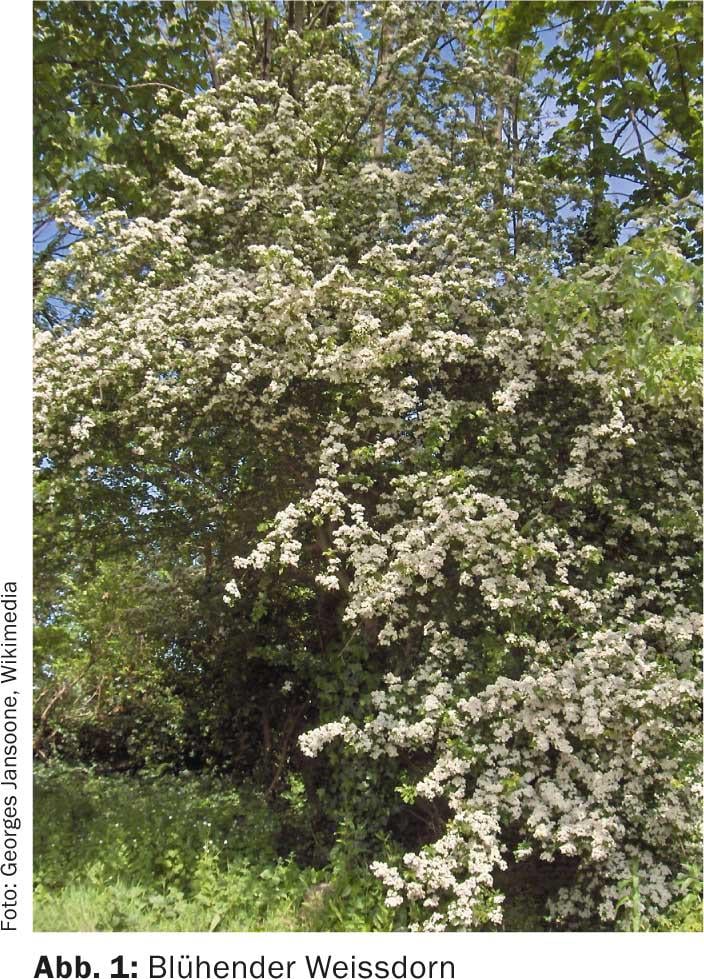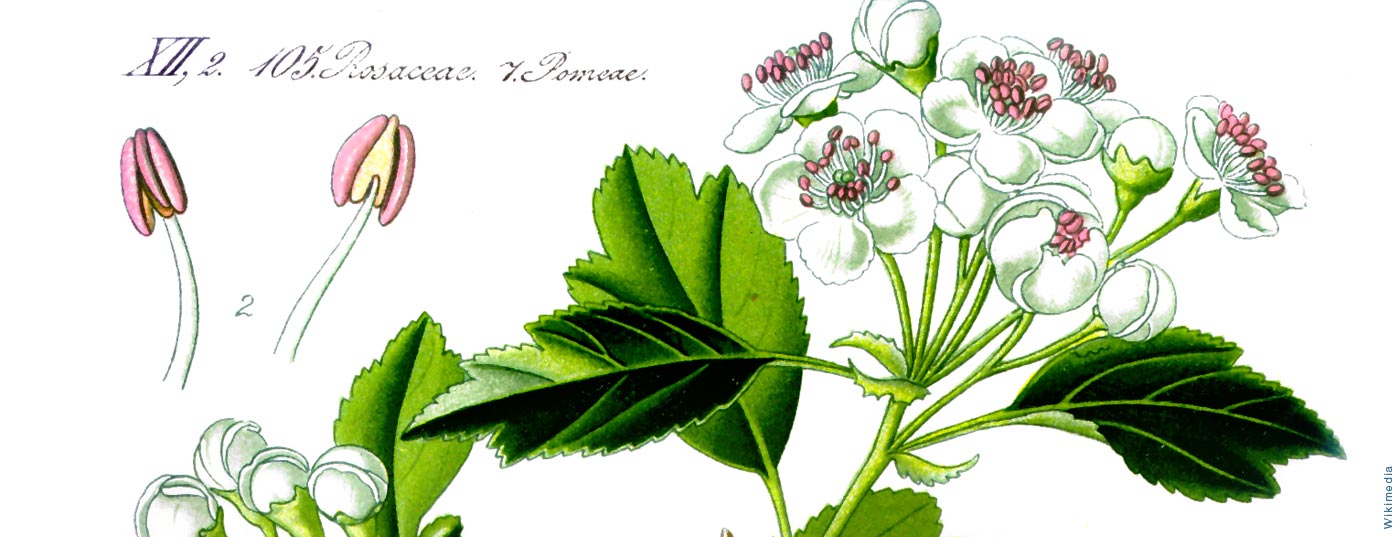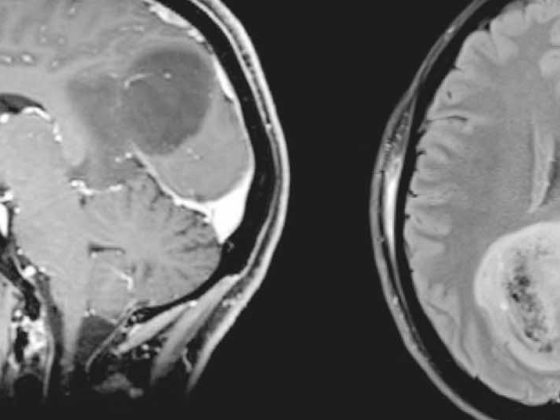Corresponding complaints can also be treated phytotherapeutically in cardiology. The focus here is on hawthorn (Crataegus species), which is especially suitable for the treatment of heart complaints (NYHA I and II). There are also clinical studies on this. However, there are several other medicinal plants that are used in folk medicine and by physicians practicing phytotherapy.
When thinking of phytotherapeutic treatment of mild cardiac complaints, hawthorn (Crataegus species) is first and foremost up for discussion. And indeed, in most cases tinctures or standardized preparations of hawthorn are used for appropriate indications. Also, most of the clinical studies related to cardiac disorders have been conducted with Crataegus preparations. However, in the second part of this article, other medicinal plants will be presented that have a folk medicine tradition for the treatment of cardiac problems and are occasionally used in doctors’ offices (often in combination with hawthorn).
Hawthorn
Hawthorn, in English Hawthorn, in French Aubépine, has been known as a medicinal plant since ancient times (Fig. 1). Dioscorides already mentioned its cardioactive properties.
Crataegus is a genus of shrubs or small trees within the rose family, common in temperate zones of the Northern Hemisphere. Medicinal uses are primarily leaves and flowers (Crataegi folium cum flore), but also the pseudo-fruits (Crataegi fructus), especially of the species Crataegus monogyna and Crataegus levigata (Table 1).
Oligomeric procyanidins such as vitexin and vitex-rhamnoside as well as glycosidic flavonols such as rutin and hyperoside have been isolated from hawthorn as active constituents, in addition to 0.5-1% tannins.


Pharmacology and clinic
Various pharmacological studies on isolated organs have shown the following effects in animal experiments [1]: Positive inotropic, increase in myocardial blood flow, positive dromotropic, negative bathmotropic, decrease in peripheral vascular resistance.
NYHA: What indications can be derived from these pharmacological results? Several clinical studies demonstrate efficacy of appropriate hawthorn preparations in NYHA I and II [2–4]. Subjective complaints were improved, a reduction in the pressure-frequency product was noted, and an increase in work tolerance was determined.
Mortality and morbidity: The SPICE trial published in 2008 [5] showed a significant improvement in survival prognosis in patients with NYHA II or III and a left ventricular ejection fraction (LVEF) ≤35% who were additionally treated with the standardized Crataegus extract WS 1442 (Table 1) in addition to conventional pharmacotherapy, especially in patients with an LVEF of 25-35%.
Hypertension: In contrast to studies that failed to identify an association between Crataegus preparations and blood pressure reduction, Walker AF et al. In 2002 [6], a four-arm study in which subjects were given daily
- 600 mg magnesium or
- 500 mg LI 132 (Tab. 1) or
- 600 mg magnesium and 500 mg Li 132 or
- Placebo
received. A reduction in diastolic and systolic blood pressure was found in all four groups, but without a relevant advantage of one group over the others. For diastolic blood pressure, however, the LI 132 group (at week 10) showed a promising reduction (p=0.081) compared to the other groups after a factorial contrast analysis, as well as a trend for reduced anxiety. This is consistent with the folk medical use of hawthorn: Calms the heart and mind.

Cochrane Review
In contrast to other Cochrane reviews that found many medicinal plants lacking efficacy, a review published in 2009 by the Cochrane Collaboration confirmed the efficacy of hawthorn extract for chronic cardiac symptoms [7]. This meta-analysis evaluated 14 randomized double-blind trials, eleven of which used hawthorn extract WS 1442 and three of which used LI 132. The Cochrane authors concluded from the results obtained that the two hawthorn extracts used were superior to placebo in chronic cardiac complaints of NYHA I, II, and in three studies also NYHA III, alone or as an adjunct medication.
Other medicinal plants
In addition to hawthorn, which is clearly dominant in cardiovascular complaints, there are other medicinal plants that have a folk medicine tradition for treating mild cardiac complaints. These include:
- Snakeweed (Rauwolfia serpentina)
- Mistletoe (Viscum album)
- Garlic (Allium sativum)
- Olive tree (Olea europaea)
- Heartwort (Leonurus cardiaca)
- Bush clover (Lespedeza capitata)
- Melissa (Melissa officinalis).
However, of these medicinal plants, there are few, if any, significant studies that demonstrate efficacy for heart conditions. Nevertheless, they are always used by doctors and physicians with appropriate experience, mostly as tinctures and often as a mixture of tinctures. In such mixtures, hawthorn is often prescribed with snakeroot (Rauwolfia) or with olive tree extract for treatment or adjunct treatment of hypertension.
The tincture mixtures in Table 2 have proven useful for the treatment of hypertension, depending on the severity as an additional medication.
Phytotherapeutic physicians point out possible contraindications when using Rauwolfia, which correspond to those of preparations containing reserpine. Hawthorn can also be used in younger people suffering from palpitations, for example in combinations with lemon balm. Another application for hawthorn is menopausal heart palpitations. During such an attack, Ceres Crataegus (five drops) can be taken and salivated well. If necessary, you should repeat this after five to ten minutes.
Literature:
- Melzer J: Hawthorn: An underestimated therapeutic potential in heart failure and nervous heart complaints. Phytotherapy 2005; 5(5): 10-11.
- Melzer J, et al: Crataegus berries: heart complaints, congestive heart failure NYHA I and II – a systematic review. Perfusion 2003; 16: 358-362.
- Rietbrock N, et al: Efficacy of a standardized extract of fresh Crataegus berries on exercise tolerance and quality of life in patients with heart failure (NYHA II). Drug Research 2001; 51: 793-798.
- Degenring FH, et al: A randomised double blind placebo controlled clinical trial of a standardised extract of fresh Crataegus berries (Crataegisan) in the treatment of patients with congestive heart failure NYHA II. Phytomedicine 2003; 43: 637-642.
- Holubarsch CJF, et al: The efficacy and safety of Crataegus extract WS 1442 in patients with heart failure: The SPICE trial. J Eur Heart Fail 2008; 10: 1255-1263.
- Walker AF, et al: Promising hypotensive effect of hawthorn extract: a randomized double-blind pilot study of mild, essential hypertension. Phytother Res 2002; 16: 48-54.
- Guo R, Pittler M, Ernst E: Hawthorn extract for treating chronic heart failure (Review), 2009 The Cochrane Collaboration, Published by John Wiley&Sons, Ltd.
HAUSARZT PRAXIS 2014; 9(9): 6-7











